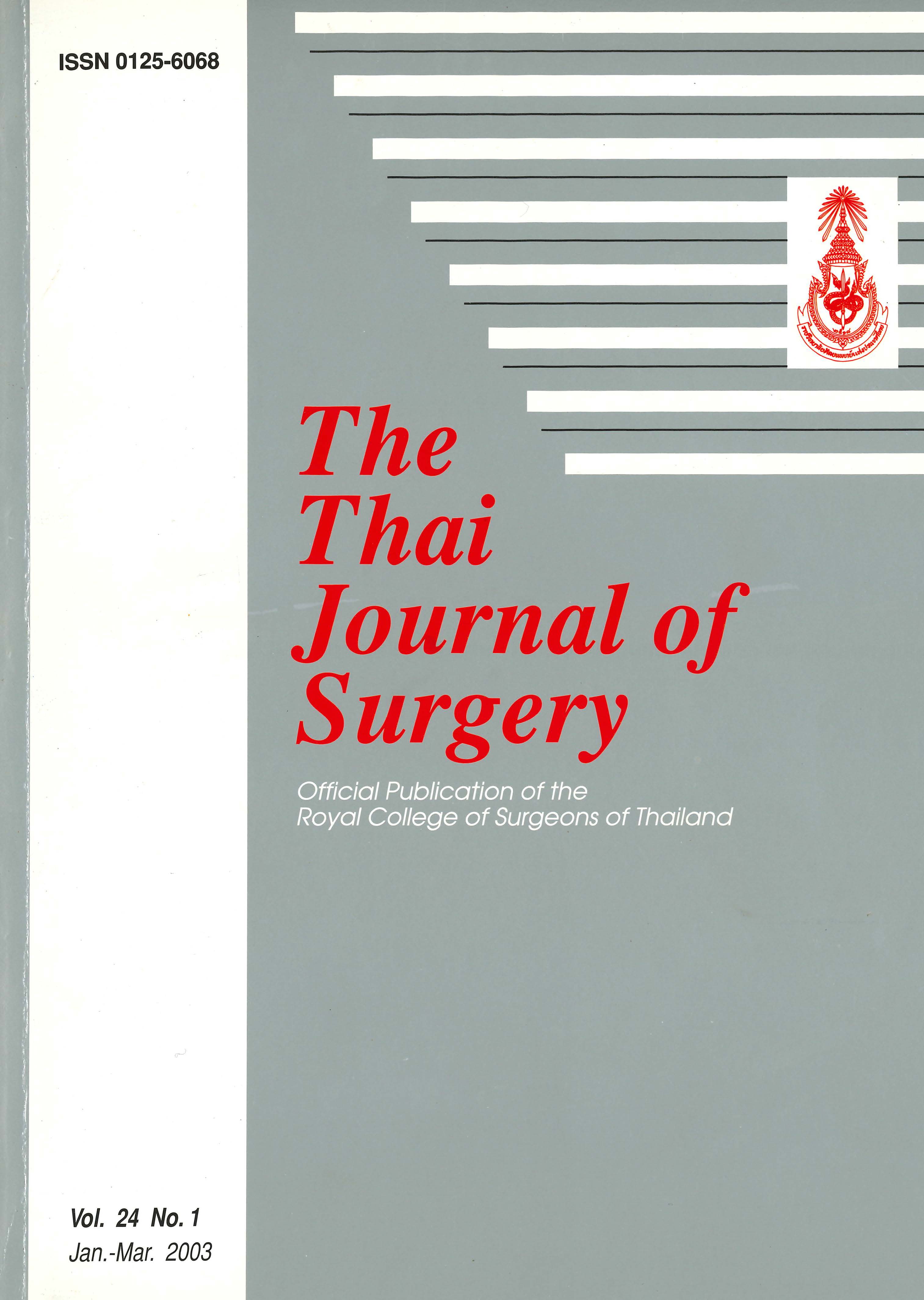Physical Abuse in Children: A Surgeon 's Perspective
Abstract
Background: Physical abuse in children is one category of child abuse which surgeons are usually consulted. Its prevalence is anticipated to be increased as a result of the more stressful society. The natures of the victims, the perpetrators, the injuries, the management and its outcomes are the crucial data for the handling of this complicated problem.
Materials and Methods: Retrospective data collection was carried out from the records of all children diagnosed with physical abuse, who were admitted to the Children's Hospital, Bangkok, during a recent ten-year period (1992-2001).
Results: Of the 12 intentionally injured children, all but one were younger than 5 years of age, and half were younger than I year of age. Two-thirds of these abuses occurred in the last 4 years. Ten abusers were males. Head injury, abdominal injury, fractures, skin and soft tissue injuries were seen in 5, 6, 7, and 11 patients respectively. Several of whom had multiple injuries. Seven patients required surgical intervention: two for head injury, and five for abdominal injury. One patient died from massive hemorrhage. Of the eleven who recovered; two were discharged home, but nine ended up in charitable institutions.
Conclusion: The victims of physical abuse were usually very young infants. Direct blows and beating were the mechanism of assault. Head and abdominal injuries were often severe and required surgery. Fractures were mostly multiple and thus were a good clue to the diagnosis. Long-term fate of these victims are miserable.
References
2. Silverman FN. The roentgen manifestations of unrecognized skeletal trauma in infants. Am J Roentgenol 1953;69:413-27.
3. Woolley PV, Evans WA. Significance of skeletal lesions in infants resembling those Of traumatic origin. JAMA 1955;158:539-43.
4. Kempe CH, Silverman FN, Steele BF, Droegemuller W, Silver HK. The battered child syndrome. JAMA 1962; 181: 17-24.
5. Caffey J. On the theory and practice of shaking infants. Am J Dis Child 1972; 124: 161-9.
6. Billmire ME, Myers PA. Serious head injury in infants: accident or abuse? Pediatrics 1985; 75: 340-2.
7. Buys YM, Levin AV, Enzenauer RW, et al. Retinal findings after head trauma in infants and young children. Ophthalmology 1992;99:1718-23.
8. Ledbetter DJ, Hatch El, Feldman KW, Fligner CL, Tapper D. Diagnostic and surgical implications of child abuse. Arch Surg 1988; 123: 1101-5.
9. Cooper A, Floyd T, Barlow B, et al. Major blunt abdominal trauma due to child abuse. J Trauma 1988; 28: 1483-7.
10. Sivit CJ, Taylor GA, Eichelberger MR. Visceral injury in battered children: a changing perspective. Radiology 1989; 173: 659-61.
11. Kleinman PK, Rastopoulos VD, Brill PW. Occult nonskeletal trauma in the battered-child syndrome. Radiology 1981;141:393-6.
12. McCort J, Vaudagna J. Visceral injuries in battered children. Radiology 1964; 82: 424-8.
13. O'Neill JA, Meacham WF, Griffin PP, et al. Patterns of injury in the battered child syndrome. J Trauma 1973; 13: 332-9.
14. Touloukian RJ. Abdominal visceral injuries in battered children. Pediatrics 1968; 42: 643-6.
15. Merten DF, Carpenter BLM. Radiologic imaging of inflicted injury in the child abuse syndrome, Pediatr Clin North Am 1990;37:815-37.
16. Ziegler DW, Long JA, Phillippart Al, Klein MD. Pancreatitis in childhood: experience with 49 patients. Ann Surg 1988;207:257-61.
17. Pena DJ, Medovy H. Child abuse and traumatic pseudocysts of the pancreas. J Pediatr 1973;83: 1026-8.
18. Slovis TL, Berdon WE, Haller JO, Baker DH, Rosen L. Pancreatitis and the battered child syndrome: report of two cases with skeletal involvement. Am J Roentgenol 1975; 125: 456-61.
19. Morzaria S, Walton JM, MacMillan A. Inflicted esophageal perforation. J Pediatr Surg 1998; 33: 871-3.
20. Merten DF, Radkowski MA, Leonidas JC. The abused child: a radiological reappraisal. Radiology 1983; 146: 377-81.
21. Kleinman PK, Marks SC, Blackbourne B. The metaphyseal lesion in abused infants: a radiologic histopathologic study. Am J Roentgenol 1986; 146:895-905.
22. Kleinman PK, Marks SC. Relationship of the subperiosteal bone collar to metaphyseal lesions in abused infants. J Bone Joint Surg Am 1995; 77: 1471-6.
23. Oates K. Child abuse: recognition and response. Proceedings of the 5th Asean Pediatric Federation Conference on Trauma in Childhood. Kuala Lumpur. 1990:98-103.
Downloads
Published
How to Cite
Issue
Section
License
Articles must be contributed solely to The Thai Journal of Surgery and when published become the property of the Royal College of Surgeons of Thailand. The Royal College of Surgeons of Thailand reserves copyright on all published materials and such materials may not be reproduced in any form without the written permission.



